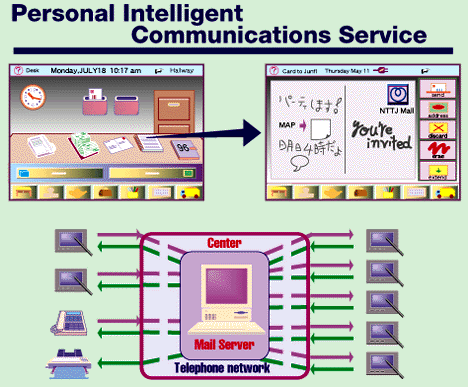 |
 |


|
 |
 |
 |


|
 |

This experiment consisted of basic software "Magic Cap" for personal information communicators and a communications programming language called "Telescript(TM)" developed by General Magic of the US, in which NTT has invested, and a portable terminal developed by Sony. The palm-size terminal included network service which allowed on-line communications including hand-written messages, voice data and simple animation.
A pocket pager was used to inform users that electronic mail, or e-mail, had arrived. Compared with e-mail retrieved using a conventional PC, anyone can easily perform the necessary operations, meaning the system allowed users to joyfully and playfully send and receive messages with full expression anywhere and at anytime. In other words, a revolutionary multimedia communication tool was introduced.
One of four main pillars to NTT's approach to the multimedia age is strengthened user installation technology (software). This experiment was conducted as one link in this approach. With computer downsizing and a technological revolution in high performance functions and with diversifying information needs, a new type of service heretofore unseen in the communication industry has arrived and is expanding globally. In the midst of this trend, NTT seeks to make its service development and technological development even stronger, to increase international activity even further, and to promote links between various corporations inside and outside Japan.
An "agent" (electronic agent) is a metaphor for a program written in Telescript(TM) that can perform network services for an individual according to his instructions. For example, if the user issues an instruction such as "search for a hotel meeting these conditions and make reservations", the agent will search the network for such a hotel against the conditions given, compare rooms, make reservations, and put an entry in the individuals notebook and/or calendar. This also offers high reliability in terms of safely protecting personal information.
Since agent communications capable of features like this are capable of flexibly utilizing network resources, they are gaining much attention for the important role they might play in multimedia.This is because the Telescript(TM) language used to implement the agent is object-oriented in that action (do) and data (this) are handled as a capsule. By installing a Telescript(TM) engine (a program capable of interpreting and executing the Telescript(TM) language) at the terminal, network and center, the agent can freely run around the network from terminal to center taking care of one's personal business.
The service tested was named "Paseo". Currently, we are at the stage where we are coordinating information providers to the network. As network contents come into place, the ability to do things like make the hotel reservation described earlier using an agent will become possible. As multimedia becomes more personalized, we expect "Paseo" to divine the future of agent services.
